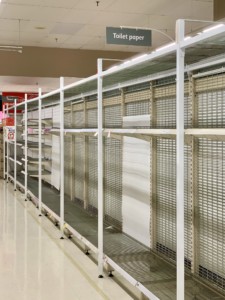 If you have been shopping lately, you may have noticed that due to the Corona virus crisis, your store is running short on some items like toilet paper, hand sanitizer, pasta, and other consumables with a longer shelf life. Even my next-door supermarket has been hit by the panic buying.
If you have been shopping lately, you may have noticed that due to the Corona virus crisis, your store is running short on some items like toilet paper, hand sanitizer, pasta, and other consumables with a longer shelf life. Even my next-door supermarket has been hit by the panic buying.
Since my semester just got postponed by four weeks for the same reason, I have lots of time to write and would like to dig deeper into the situation of the toilet-paper supply chain.
Update 13.04: The purchasing of the consumers continued to outstrip the supply chain. Over weeks the demand was 150% or more of the usual, and only now toilet paper is slowly returning to the stores. While the processes described below are still correct, I am surprised about the duration of the demand peak!
The Usual Situation
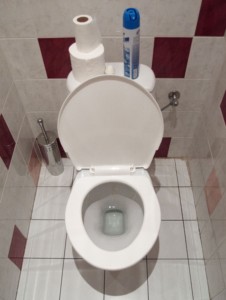 Many products have seasonal demand variations. For example, people eat more ice cream in the summer than in the winter. Toilet paper does not. No matter what time of the year, actual consumption of toilet paper is pretty constant. The consumption of toilet paper changes usually only with the growth of the population.
Many products have seasonal demand variations. For example, people eat more ice cream in the summer than in the winter. Toilet paper does not. No matter what time of the year, actual consumption of toilet paper is pretty constant. The consumption of toilet paper changes usually only with the growth of the population.
It is an important product, with around €40 billion revenue per year worldwide. How much paper is consumed depends, for one thing, on the country and its culture. On one end, the average American consumes around 25 kilogram of hygiene paper per year (which includes also tissues, paper towels, and other similar products). On the other end, the average Indian consumes only 123 grams of hygiene paper per year.
 The consumption is also very different by gender. The average person consumes 140 rolls per year in the USA, and less in other countries, or around 12 per month. This seems to differ significantly between the sexes, and women consume quite a bit more toilet paper. While hard data is difficult to come by, anecdotal evidence ranges from twice to ten times more. For women the cleaning procedure is more frequent, the to-be-cleaned area is larger and has a more complex geometry, and women also … often have a higher standard of hygiene than men. Also, few men ever had to dispose of a menstrual pad, which also consumes more toilet paper.
The consumption is also very different by gender. The average person consumes 140 rolls per year in the USA, and less in other countries, or around 12 per month. This seems to differ significantly between the sexes, and women consume quite a bit more toilet paper. While hard data is difficult to come by, anecdotal evidence ranges from twice to ten times more. For women the cleaning procedure is more frequent, the to-be-cleaned area is larger and has a more complex geometry, and women also … often have a higher standard of hygiene than men. Also, few men ever had to dispose of a menstrual pad, which also consumes more toilet paper.

Hence, usually there are few changes in the consumption of toilet paper. Even a diarrhea epidemic makes only a small bump in the consumption of toilet paper. The same goes for new Avatar films when fans recreate the “Tree of Souls” of the blue-skinned Na’vi using toilet paper.
Hence, it is usually easy to establish pull along the toilet-paper supply chain. The fewer fluctuations you have along your supply chain, the easier it is to manage the supply chain. In normal times, the demand is rather constant and has few fluctuations. There still needs to be buffers due to fluctuations in the supply, but the system is set up for a constant and hence cheap production output.
The Toilet-Paper Supply Chain
Let’s have a look at a typical toilet-paper supply chain. Very simplified and ignoring the material supply for the manufacturer, it starts from toilet-paper manufacturing. The distribution system brings it from the manufacturer to the wholesaler, and from there onward to a supermarket. There it is bought by you and brought home into a (usually) small stockpile before it becomes very familiar with your body, after which nobody wants it anymore and it is discarded.
Toilet-Paper Manufacturing
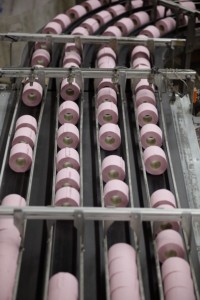 Toilet paper is one of the cheapest goods by volume that you can find in a supermarket. Hence it makes little sense to produce it abroad, and most regions have one or more local manufacturer nearby that provide the stuff.
Toilet paper is one of the cheapest goods by volume that you can find in a supermarket. Hence it makes little sense to produce it abroad, and most regions have one or more local manufacturer nearby that provide the stuff.
These manufacturers operate close to their usual output. A paper machine is a rather expensive product, and manufacturers try to run it around the clock anyway. Hence, there is not much option to increase capacity. There may be an idle plant that goes online, or maintenance can (not necessarily should) be reduced. Overall, production is increased very little. And, as we see later, it should not be. If they put in a lot of effort now to increase capacity, they would have to put in a similar effort later to reduce capacity, since the overall demand does not change!
If you suddenly sell more ice cream, it is safe to assume that people eat more ice cream, which is good for the ice-cream maker. If you suddenly sell more toilet paper, it is safe to assume that people do NOT use more toilet paper, they just increase their stockpile. This is not good for the toilet-paper maker, as this creates an artificial demand fluctuation and can lead to the bullwhip effect. Besides, the problem with the empty shelves in supermarkets does not stem from the manufacturer, but the other part in the supply chain.
Toilet-Paper Warehouse
From the manufacturer, the toilet paper is brought to different wholesale warehouses. These are usually multiple trucks per day departing from a manufacturer.
And these warehouses are full. They have about one month’s worth of toilet paper on inventory. Below is a video of a Dutch worker in a toilet-paper warehouse, making fun of the panic buying, and his colleagues also think it is ridiculous. He does like the panic buying, however, since he makes nice money working overtime.
Toilet-Paper Supermarket
So why is there no toilet paper restocked in the supermarket? The problem is the shipping between the warehouse and the supermarket. For products in high demand or which spoil quickly, a truck may come every day. Toilet paper and pasta are usually not such a high demand, and they don’t spoil that fast either. Hence, many supermarkets have a truck for toilet paper only every few days. This means that if there is a run on a store, it won’t be stocked immediately, but two or three days later. In short, the pull system between the warehouse and the supermarket is set up for much smaller demand swings, and is currently overwhelmed by the sudden and often irrational demand swings.
Below are the toilet-paper chronicles of my nearby supermarket. On Monday, March 9, I noticed emptying shelves for the first time. However, products were arriving, and the shelves were only slightly below average on March 13. Yet on Saturday, the traditional German shopping day, the hordes bought it all, and the shelves were bare. Even so, I am confident that the shelves will be restocked shorty.
Supermarkets are of course reacting. Based on the current rush on toilet paper, they will probably increase both the size and the frequency of the order until the crisis has passed and the situation is back to normal. This means means more need for truckers and for workers in the supermarket to restock the shelves. In Germany, trucks are usually not allowed to drive on weekends, but there is a temporary regulation in most German states that permit trucks on weekends for toilet paper, pasta, and other dry goods to alleviate the perceived shortage. Some stores also limited the number of items per customer to ensure people that really need it still got a roll. Another option would be increasing the price to adjust supply and demand, but luckily this seems to have been done only sparingly. It may be more of a challenge to redirect foods packaged for restaurant use towards supermarkets, as this may need quite some reorganization of the supply chain.
Toilet Paper at Home
The toilet paper sells out because of hoarding. Some customers are in a panic mode and buy excessive amounts of toilet paper. If a few people buy more, the stock in the supermarket will run out. There are reports of people buying four hundred rolls (around nine months’ of supply for a family of four), or even all the toilet paper in multiple stores for reselling. Here’s an interview with a guy that did the same thing with hand sanitizer. Since Amazon pulled his listings for price gauging ($70 for a bottle of hand sanitizer that costs usually around $3), he now has 17,700 bottles in his garage and doesn’t know what to do with it.
 While some have way too much, others who wanted to buy properly “just in time” are now running out of toilet paper. In effect we have the opposite of leveling. Some have a huge inventory … which they won’t consume any faster than normal anyway, and others are running out.
While some have way too much, others who wanted to buy properly “just in time” are now running out of toilet paper. In effect we have the opposite of leveling. Some have a huge inventory … which they won’t consume any faster than normal anyway, and others are running out.
On Pasta
The situation with pasta is similar. Below are my chronicles of pasta in my closest supermarket. Did I mention that I have time due to the semester being postponed by four weeks? Anyway, I noticed less pasta first on March 5. But it was all restocked one day later. The Monday afterward, they even managed to bring in an extra pallet due to excess demand. This inventory lasted till Friday. On Saturday the crisis was at full swing, and the shelves were bare. Even the unpopular dinkel wheat pasta was completely gone, although they still had Cannelloni and German soup noodles. But this shortage is only temporary, since the supply is not as frequent as the current demand, and I am sure the shelves will be filled again soon.
The situation is different, however, with hand sanitizers and face masks. These are indeed out of stock, as the demand currently far exceeds the supply.
Summary
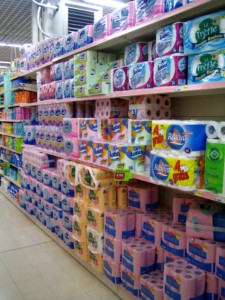 However, with toilet paper and pasta, you will be fine (soon). Even though you will see lots of images of empty shelves, don’t worry (unless you are on your last roll at home). Supply will come soon (unless of course you live in the United Kingdom. In this case consider the current situation just an introductory course to Brexit). The current demand spike just overwhelms the last leg from the warehouse to the supermarket.
However, with toilet paper and pasta, you will be fine (soon). Even though you will see lots of images of empty shelves, don’t worry (unless you are on your last roll at home). Supply will come soon (unless of course you live in the United Kingdom. In this case consider the current situation just an introductory course to Brexit). The current demand spike just overwhelms the last leg from the warehouse to the supermarket.
Besides, other stores may have toilet paper in stock, it is just not newsworthy to post images of full shelves at the supermarket. Such panic buying happens every now and then, as for example during Hurricane Catharina. Or even for no reason at all, when in 1973 there were some rumors of a toilet paper shortage. People believed it, went shopping, and made the rumor come true. But, be nice to the staff at the supermarket, they are having a tough job right now with lots of work restocking the shelves, and unhappy, worried customers.
Also, imagine the inconvenience of having no toilet paper compared to having no toilet at all! This will happen if you flush kitchen towels or other substitutes down the toilet. It will clog up your pipes, and your loo will become a poop fountain. If you must use kitchen towels, put them in a trash bag after use but not into the toilet itself.
This doesn’t mean not to stockpile. The American Red Cross, for example, recommends two weeks of food and supply at home to prepare for a disaster. For a family of four, this would be twenty rolls of toilet paper. There is a whole Prepper community preparing for the end of the world. But if you go down this rabbit hole, be ready to meet lots of weirdos that like guns. And, don’t go out buying 3 months of supply in the supermarket right now, since this just makes it worse for everybody else. Now, stay home, wash your hands (do it!), and organize your industry from your home office!

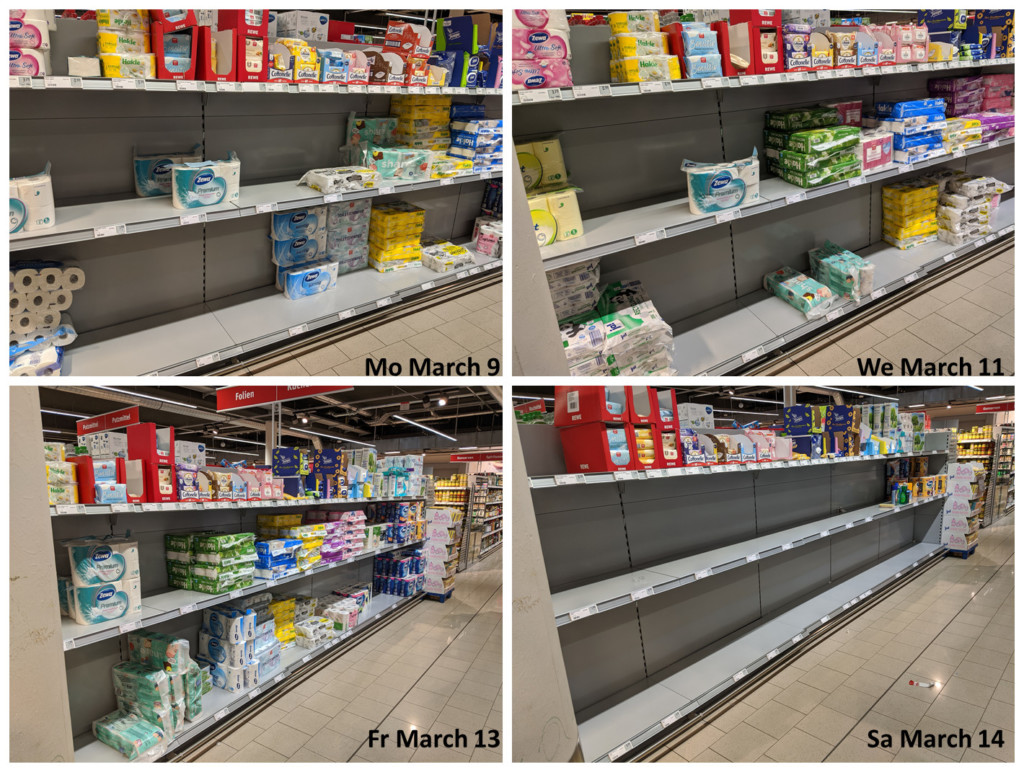

Excellent article to understand the supply chain
It seems highly unlikely that women, on average, use, on average, 20 rolls/month, since that is practically a roll per day. Can you publish the source of your data?
Hi Dick, the source is admittedly not scientific but more anecdotal, with some quite high consumption reported https://www.forum-3dcenter.org/vbulletin/archive/index.php/t-130425.html https://www.geizkragen.com/forum/der-platz-fuer-diverse-themen-und-fragen/18423-toilettensache.html
In Germany the total consumption is 134 rolls per person and year, which gives around 10 rolls per person and month. America is a tad higher with 141 rolls per person and year https://de.statista.com/infografik/15624/klopapierverbrauch-pro-kopf-in-ausgewaehlten-laendern/
In any case, I have rephrased the section and removed the “20” rolls. If you are measuring the purchase of your TP, keep in mind that in normal times people do a lot of their business away from home (at work, at School, in the restaurant, …), which should also be counted towards the total consumption.
My mom is on diuretics. She uses TWO rolls a day. It’s not uncommon for older women to also use toilet paper as a panty liners
Toilet paper manufacturers ran their machines 24/7 before Coronavirus due to the high acquisition cost of those machines – they have little capacity to increase production.
Apparently commercial manufacturers (i.e. scratch-your-butt TP) can’t easily switch to the more plush consumer TP, so they can’t make up the demand either. GM can start making ventilators, but these people can’t just start making a thicker type of TP for home use.
Supply is not being increased to meet the demand. We will be SOL until people can go back to work.
https://www.vox.com/the-goods/2020/4/3/21206942/toilet-paper-coronavirus-shortage-supply-chain?fbclid=IwAR1Auuk6mj2JTGokTQroHi-2_-4jspCTF6LqEiBY7B7F_-FY8b4kovOUCWc